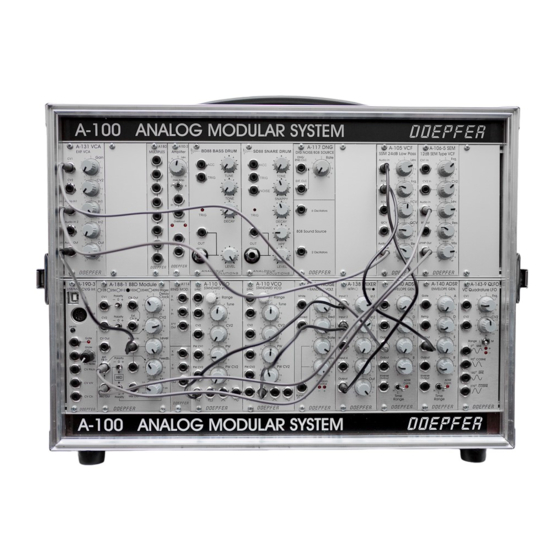Die Kabel durch das Loch bei der
Endmontage vorsichtig zurückziehen.
during the final assembly the wires have
to be tracked back carefully through this
hole
Zum Schluss wird das Oszilloskop wieder
zusammengebaut. Die Kabel werden dabei durch das Loch
in der Gehäuserückwand vorsichtig wieder zurückgezogen.
Die Kabel können zusätzlich an dem Loch mit einem
Heißkleber als Zugentlastung fixiert werden.
Beim Anschluss des Bussteckers an die A-100 Busplatine
unbedingt auf korrekte Polung achten. Eine falsche Polung
kann das LCD-Modul zerstören !
Die farbige Ader des Bussteckers (-12V) wird ja für das
LCD-Modul nicht benötigt und ist nur als kurzes Reststück
vorhanden. Diese Seite des Bussteckers muss – wie bei
allen A-100-Modulen – nach unten weisend auf die
Busplatine ohne Versatz aufgesteckt werden. Achten Sie
speziell bei diesem Modul sehr genau auf die korrekte
Steckposition, da das LCD-Modul sehr teuer ist.
Die 4 rechten Buchsen unterhalb des Oszilloskop-Rahmens
bilden ein Vierfach-Multiple und sind mit dem Messeingang
des VPS10 (BNC-Buchse) verbunden. Es ist kein spezielles
Messkabel mit BNC-Stecker erforderlich, sondern es
können normale A-100-Patchkabel verwendet werden. Die
4 linken Buchsen bilden ein unabhängiges Vierfach-Multiple
und sind nicht mit dem VPS10 verbunden.
Wichtige Hinweise:
•
Wir übernehmen keine Verantwortung bei nicht
fachgerechtem Anschluss und Einbau des VPS10-
Moduls.
•
Bitte beachten Sie die Hinweise des Herstellers des
VPS10 (Vellemann), die dem LCD-Scope beiliegen.
•
Die Montage und Verdrahtung des VPS10 kann bei
nicht sachgemäßer Handhabung einen Verlust des
Garantieanspruchs zur Folge haben.
•
Die Bedienung des VPS10 ist in der
Bedienungsanleitung des Herstellers beschrieben.
•
Wir sind nicht für die Eigenschaften und Funktionen
des VPS10 verantwortlich, sondern bieten nur den
Einbausatz an !
Then the scope module is reassembled. The cables have to
be tracked back carefully through the hole to avoid a cable
mess inside the VPS10 case. The cables can be fixed at the
hole e.g. with a hot-melt adhesive.
Pay attention to the correct polarity and position of the bus
connector if it is attached to the A-100 bus board. A wrong
polarity of position may destroy the VPS10 !
The colored wire of the bus cable (i.e. – 12V) is not used for
the VPS10 and is available only a short remnant at the bus
connector. This side of the bus connector has to point to the
bottom (same as for all modules). Pay attention to a correct
polarity and position especially for this module as the LCD
scope VPS10 is very expensive.
The four right sockets below the scope form a four-fold
multiple and are connected to the measuring input of the
VPS10 (BNC socket). No special measuring cable with BNC
plug is necessary but normal A-100 patch cables can be
used. The four left sockets form an independent four-fold
multiple and are not connected to the VPS10.
Important notes:
•
We do not take on responsibility if the VPS10 is not
wired and mounted correctly.
•
Pay attention to the documents and remarks that
come together with the VPS10.
•
Wrong wiring or mounting of the VPS10 may affect
the warranty !
•
The operation and functions of the VPS10 are
described in the VPS10 user's manual that is
attached to the VPS10.
•
We are not responsible for the features of the
VPS10 but offer only a kit to mount the VPS10 into
the A-100 system. If you have questions that relate
to the functions or features of the VPS10 please
contact Velleman.

